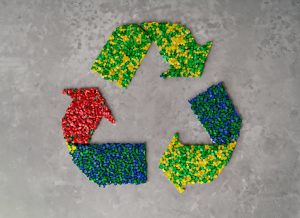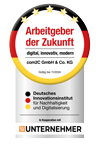Walking across carpets with rubber soles, combing with a plastic comb, taking off a synthetic fiber sweater: Electrostatic charges occur almost everywhere in our everyday lives. They can be perceived by humans from a voltage value of around 2,000 V. Effects in print or in print finishing can, however, occur at much lower values.
One speaks of a static charge when there are atoms with a lack of electrons (positive charge) or an excess of electrons (negative charge) on the surface of a body. In the case of electrically conductive materials such as metals, for example, the electrons can move freely and flow away accordingly. In the case of non-conductors, like most print media, they remain immobile on the surface – the material is statically charged.

How is electrostatic charging created?
Static charge This can be caused by friction or the separation of workpieces, especially if the charge cannot drain off due to rubber rollers or other plastic machine parts that have an insulating effect. Satin surfaces are particularly susceptible to static charging. In addition to the processing speed, a major influencing factor is the room temperature and humidity. Warm, dry air promotes the formation of static electricity.
Unsightly effects of static electricity in the print
The effects of charging can lead to disruptions in all printing processes and also in laminating/coating. The charge promotes the attraction of dust particles and can disturb the printed image, especially the typeface. The print result can be fuzzy or fuzzy, print heads can get dirty.
In order for the fine ink droplets of an inkjet printer to land precisely, they receive a positive electrical charge. If the material to be printed is statically charged, the trajectory of the ink drop will be deflected. This has a negative effect on the print result: Typically, the effects are most noticeable in parts of the image with low color saturation, for example in pastel tones, skin tones or light gray tones. Here it comes to Stains, swirls, polka dots or other irregularities. The print often looks ugly or dirty to the end customer. Complaints and reprints can be the result.
When lining or laminating are dust particles a problem. Static charging promotes the attraction of the finest dust particles - if work is not carried out under clean room conditions, contamination and inclusions can then occur.

What helps with electrostatic charging?
Here we present some common ones relief measures in the event of electrostatic charging in the printing process or in further processing.
The biggest problems with electrostatic charging arise in dry and warm air. A change in the room climate can help here. A relative humidity of 50 to 55% and a room temperature of 20 to 23°C are considered optimal. An industrial humidifier can be used against air that is too dry.
Ionized air accelerates electrostatic charges on bodies. An ionization device can be used for this purpose, which delivers ionized air specifically to devices and equipment that can be charged more strongly or to components that are particularly at risk. This measure has a spatially limited effect and is ideal for particularly vulnerable areas in the production process.
Ionizing devices are available in various designs, for example as an antistatic ceiling fan, in the form of a pistol or as an ionizing bar.
A silicone material roller can pick up dust particles without scratching delicate surfaces.
An anti-static spray can increase the conductivity of surfaces for a short time and thus prevent disturbances during printing and further processing that are caused by electrostatic charging. An antistatic spray contains surfactants and is only effective until the fine layer it forms is removed again, for example by friction.








